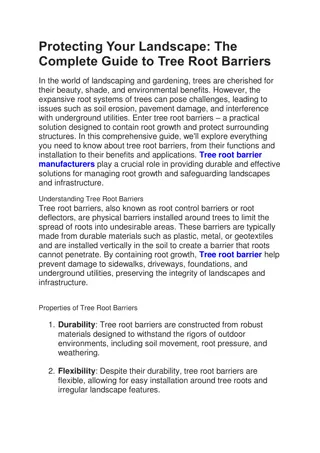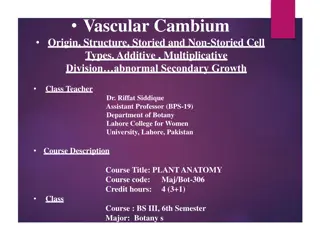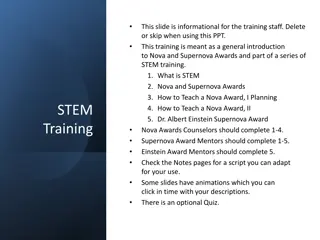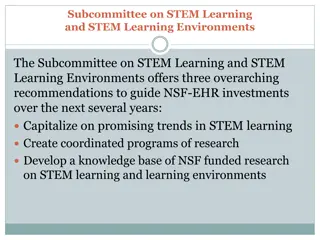Understanding Vascular Transition in Root-Stem Structure
Root and stem in plants form a continuous structure with a transition region between them. The transition involves twisting and inversion of xylem strands, leading to variations in vascular bundles. Eames and Mac Daniels identified different types of vascular transitions in dicots and monocots, each with unique characteristics in xylem and phloem arrangement. This transition process plays a crucial role in the differentiation of root and stem structures in plants.
Download Presentation

Please find below an Image/Link to download the presentation.
The content on the website is provided AS IS for your information and personal use only. It may not be sold, licensed, or shared on other websites without obtaining consent from the author. Download presentation by click this link. If you encounter any issues during the download, it is possible that the publisher has removed the file from their server.
E N D
Presentation Transcript
ROOT STEM TRANSITION M. Sc IInd Semester By Dr. Manju Philip Head, Dept of Botany
ROOT STEM TRANSITION Root and stem forms continuous structure So there is a transition region in between root and stem. Epidermis, cortex, endodermis, pericycle and the secondary vascular tissue are continuous from root to stem. Radially arranged independent strands of xylem and phloem present in root- xylem exarch. Collateral xylem and phloem in stem- xylem endarch.
Twisting and inversion of strands involves in the transition of xylem . Transition occurs either gradually or abruptly. Length of transition region varies from <1mm to 3mm or rarely several cm. It may occur in the top of radicle , at the very base of the hypocotyl, near its centre or in the upper part. Therefore hypocotyl may possess either root structure or stem structure. Multiplication of vascular bundles, forking, rotation and fusion of strands occurs.
Eames and Mac Daniels (1947) illustrated 3 types of vascular transition in dicots and 1 type in monocots. Type 1: Four strands of xylem and phloem in root. Phloem remains unchanged in position. Each xylem strand splits radially into 2 halves and swing upward laterally.(One to left and one to right) Rotate through 180 degree results in the joining of inverted xylem at the inner side of the phloem-collateral vascular bundles. e.g., Mirabilis.
Type 1. Type 2.
Type 2: No. of xylem & phloem in root is not doubled in stem. There are 2 xylem & 2 phloem strands. Phloem become elongated and dumb-bell shaped.(Constriction appears at the middle.) No. of phloem doubled to 4 in the stem. 2 xylem strands splits radially and become inverted . The 4 halves produced then join with the phloem in the inner side. e.g., Cucurbita, Tropaeolum, Acer, & Phaseolus.
Type 3: Same no. of vascular bundles in stem &root. Different orientation in position of phloem. xylem do not split, only the change in position occurs. Inverted through 180 degree. Phloem divide into 4 strands move apart and unite with one another to form 2 strands. (half of one strand with half of the other.) phloem joins the xylem on the outer side. e.g., Lathyrus, Medicago, Phoenix.
Type 3. Type 4.
Type 4: No. of vascular bundle in stem is reduced to half in the root. 4 strands of phloem in root. These unite to form two strands. One diagonal xylem get inverted through 180 degree. The other pair splits radially into 2 halves. These halves swing laterally one to right and one to left, gets inverted through 180 degree and join with the phloem by the inner side. e.g., Anemarrhena of family Liliaceae.
ROOT-STEM TRANSITION IN BETA VULGARIS Root diarch xylem and 2 phloem strands alternating with the xylem. In the root protoxylem is exarch and this condition is maintained upto the hypocotyl. At higher level two metaxylem are differentiated towards periphery on lateral side of protoxylem. This orientation leads to the formation of endarch xylem. Diarch xylem of the root gradually became 4 stranded.
There are 2 phloem strands in the root. At hypocotyl, the phloem branches into 4 strands. Each phloem strands associates with one metaxylem plate outside- collateral vascular bundle. Epicotylary trace develops after the root- hypocotyl- cotyledon vascular strands is partially differentiated. Epicotylary traces are collateral with endarch xylem. So, there is no vascular transition in Beta vulgaris Similar case can be seen in Daucus carota
CONCLUSION Root and stem forms a continuous structure, so there is a transition region between the stem and root. Root-stem transition may occur in 4 different ways. Type1 as in the case of Mirabilis, Type2 as in the case of Phaseolus, Type3 as in the case of Lathyrus, Type4 as in the case of Anemarrhena.























